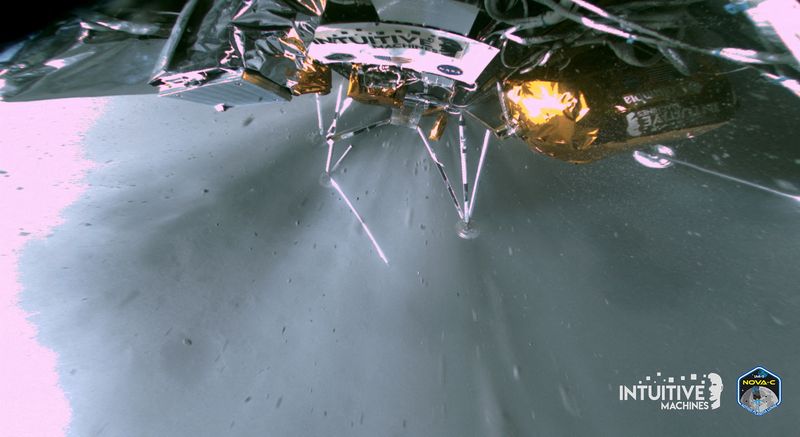By Joey Roulette
WASHINGTON (Reuters) -Intuitive Machines and its space-cargo customers expect the company to emerge stronger from its problem-plagued moon landing this week, with improvements set for the company's second lander after its first went where no private firm has gone before.
The company's Odysseus moon lander on Thursday ended its week-long mission near the lunar south pole after a mix of successes and failures that illustrated the type of risks the company and NASA, the mission's biggest backer, have come to embrace.
NASA is counting on a series of low-budget, private excursions to the moon to serve as pathfinders for missions carrying astronauts this decade. The plan allows financial room for failure and offers companies big incentives to succeed on a shoestring.
"It's a new way of going to the moon, eventually to Mars, and it's a new moon that we go to," NASA chief Bill Nelson said in an interview, calling Intuitive Machines' mission a successful example. "We don't go to a permanently lit, smoother area on the equator like Apollo, we go to a very hazardous, dark area with a bunch of pits."
Intuitive's shares - which had nearly tripled, then plummeted in wild swings over the course of the Odysseus mission - closed on Thursday up about 20% from before the launch, giving the company a market value of about $600 million.
In its final descent, Odysseus stumbled to an off-kilter landing that left it leaning sharply to one side after a series of technical problems, including the need for a last-minute workaround for a laser instrument designed to tell the spacecraft where the surface was.
The rough touchdown impeded the vehicle's functions once it arrived. NASA and the lander's commercial participants could communicate with their instruments but failed to get all the data they wanted.
Studies on galactic observations, for instance, "will not be conducted, nor will an image of the galaxy be obtained,” said Steve Durst, who led a team at the Hawaii-based International Lunar Observatory Association that put a dual-camera system on board Odysseus to capture images of the Milky Way Galaxy from the lunar surface.
Still, Durst said: "We're delighted that our country has finally touched the moon again - even though a little bit stumbling - but we're back. And that's significant."
And although other experiments were disappointing - a camera developed by students at Embry-Riddle Aeronautical University never deployed in space as intended - some worked fine.
Lonestar Data Holdings, a Houston-based startup developing space-based data centers, had a small server aboard the lander to test data transmission between Earth and the moon.
"We got everything we needed out of the mission, and we're incredibly happy," Lonestar chief executive Chris Stott said. Lonestar has already booked space on the next Intuitive Machines flight this year.
That mission, called IM-2, is sold out, and a third is planned. Intuitive chief executive Steve Altemus said Wednesday that since the landing, the European Space Agency had expressed interest in flying on one of his company's missions.
Altemus said that non-lethal mistakes had illustrated an array of improvements to make on IM-2. The most egregious mistake on the mission was forgetting to turn off a safety switch that prevented the landing laser from working; Altemus said the IM-1 team had gotten better at anticipating potential problems and workarounds.
"As we went through the mission, we got further and further ahead thinking about the possible failures, and what could get us, and what we had to fix in that certain time frame," he said.
As for the equipment, "When I think of major redesigns, I'm thinking about adding cameras, and adding antennas, things like that," he added.
Part of the mission's success was that, by past standards of space budgets, it was a bargain.

NASA put $118 million into the Intuitive Machines mission, and the company spent roughly $100 million itself.
"This was not an Apollo-era, multibillion-dollar program where a failure's not an option. These are the low-cost bets, an order of magnitude cheaper," said Chad Anderson, head of venture capital firm Space Capital. "So you get to try again."
